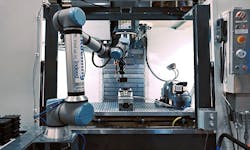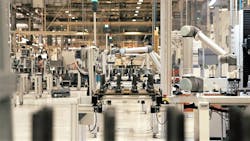Cobots—collaborative robots that can work safely alongside humans—are finding greater use in industrial environments. According to research firm SkyQuest, the global Collaborative Robot Market value was $815.40 million in 2022 and is set to grow from $914.88 million in 2023 to $2297.77 million by 2031. This suggests a compound annual growth rate of 12.2% from 2024 to 2031.
A short list of cobot applications include material handling, gluing and sealing, quality control and testing, machine monitoring, packing, packaging and palletizing, sanding, polishing, deburring and grinding. SkyQuest researchers predict the automotive industry will be the biggest adopter of cobots, with cobots capable of handling a payload up to 5 kg being the most sought after.
The International Federation of Robotics (IFR) describes four cobot types, based on the degree of collaboration between humans and robots. These are:
- Co-existential cobots that work alongside humans with no overlap of tasks.
- Sequentially cobots work with humans but not on the same product at the same time in a production sequence.
- Responsive cobots respond directly to human employees' actions.
- Co-operative cobots work alongside humans on the same task.
Alternately, ISO 10218 parts 1 and 2 defines four types of cobots—all having some levels of safety monitored stop, speed and separation, power and force limiting, and hand guiding. ThISO 10218 robot types are:
- Safety Monitored Stop cobots to handle applications with minimal interaction between the robot and humans. Integrated sensors stop operation when a human enters the workspace.
- Speed and Separation cobots are similar to safety monitored stop cobots, but use more advanced vision systems to slow operations down when a human worker approaches and stop when a worker gets too close to the cobot.
- Power and Force Limiting cobots feature rounded corners and intelligent collision sensors to detect human contact and stop operation. They use robotic arms and employ force limitations to ensure any collisions are unlikely to cause injury.
- Hand Guiding cobots integrate a hand-guided device that an operator uses to control its motion during automatic mode. In automatic mode, the robot performing hand-guiding collaboration responds only to the operator's control.
Top cobot applications
It would be easy to assume that the primary use for cobots would be any tedious or repetitive chores originally tasked to humans. However, they are capable of much more and, as time passes, cobots will be taking on more complex jobs.
Asked what the top three applications for cobots are, Justin Garski, Americas OEM segment manager, packaging and converting at Rockwell Automation, said, “Some of the top applications include palletizing slow rate products, low cycle count machine tending and quality checks. These applications are a little unique in that they don’t require high speeds or rates that can’t be met. For humans to do these things it’s not convenient as you spend more time getting to and from a work location than doing the work, or you wind up standing around idle. Neither are great options for a workforce that’s already constrained by labor shortages.”
Rapid Robotics CEO Kim Losey believes, “I tend to start with where are pain points and tasks that don't have extremely high throughput requiring speed. Also for tasks where humans are frequently injured, like palletizing, or tasks with a lot of repetition such as machine tending for intricate operations or tasks where human error is impacting profitability or product performance, like inspection.”
Losey also thinks, “We are on the verge of a new class of cobots or re-imagining what a cobot can be. The reality is that we need robots working near people to close the labor gap that continues to grow. The cobots of today are good for some tasks but need some significant advancements to handle the increasing speed and complexity we see across the supply chain.”
The pros and cons
With the ability to take on jobs that are tedious, boring and possibly injurious to humans, there appears to be no downside to cobot use in relevant manufacturing processes. However, some human workers could feel threatened by job loss to a robot and some may fear for their safety while working alongside a cobot.
In response to these concerns, Losey said, “It has been my experience that most people, once they start working with robots, actually don't resent them. Robots can pace your entire line making the whole team more productive and they are generally very reliable co-workers, and it is really cool to see humans move from laborious tasks to robot managers.”
Another factor in favor of cobots, according to Losey, is that “you can deploy them without the rigid guarding that normally comes with automation. So, in a machine tending application you can put the cobot and a rack of parts on a cart with some safety scanners and reference features and move them around job to job or machine to machine. If you did this with a traditional robot you’d have to move fencing with it too, so it quickly becomes impractical. Having that flexibility helps smaller users or users with low run rates to justify the investment in automation.”
On the downside, Losey noted, “There is this promise that cobots are safe and easy to manage or train. The truth is that they are still machines and when they are run at high speeds, they need to be behind safety barriers and all of that integration work is not quick or easy. It is also easy to overestimate what a simple cobot can do. We always tell people, if it is hard for a human, it is also hard for robot.”
Downsides or cautions noted by Garksi typically deal with misapplication of cobots. “When people see a cobot they think, anyone can set this up, I don’t need a robot specialist or machine builder,” he said. “There is a perception that you don’t need a qualified staff to set up cobots because they use tablet-like pendants and easy-to-teach functions to make them move. While that’s true, it is important to set it up the right way. There are many things that may function but aren’t good for the longevity of the cobot, such as lifting heavy loads at the far reach of travel or putting things like grinders and sanders on the end of an arm tool. In some cases, an application may even be unsafe, such as in the instance of grinding.”
Interesting applications
Although cobot use is on the rise in manufacturing, cobots are still a somewhat new technology. And, like any evolving technology, manufacturers will constantly find new and innovative ways to employ cobots as they evolve.
One such new way of using a cobot noted by Losey is their use in packing embalming fluid in boxes. “That job is not good for humans, so robots are perfect,” she said.
Another use case she cited involved Behren’s, the manufacturers of metal pails and buckets. Here, the robots “have been put to work punching holes in the buckets for the handles to be inserted. This is the perfect kind of task for a robot—strenuous, repetitive work,” she said.
“One of the more interesting things I’m seeing related to cobots revolves around their mobility,” Garski reports. “Seeing people put them on carts and move them around like a toolbox opens a lot of doors to getting extra lights out production that wouldn’t have been possible before. It’s most interesting to me simply because it delivers strong value today. Similarly, I’ve seen them mounted on autonomous mobile robots, but that requires a whole host of batteries and power to work. So, while it’s unique and interesting, it hasn’t hit the tipping point of being practical.”
Core case studies
In the past few years, cobot success stories have grown tremendously as manufacturers open up about their use of these robots. Following are highlights of four applications that highlight practical use cases across the manufacturing industries:
- SEAT Componentes, a Spain-based manufacturer of automotive gearboxes for Volkswagen and Audi, sought a way to automate the unloading of 18,000 machined gears a day at its plant. The company drew on experience from a 2015 project when it installed cobots at its shotblasting and washing stations. For this new project, the company integrated 10 Universal Robots UR10e cobots to handle the unloading process. Without requiring services of an external integrator and having previous cobot experience, the company realized guaranteed cost savings at the time of installation and in future maintenance tasks.
- Pennsylvania-based contract manufacturer Xcelicut Precision Machining was having trouble finding laborers to do the repetitive job of loading and unloading CNC machines. Cobot Systems integrated a custom CNC machine tending cobot with Xcelicut’s machinery. Xcelicut owner Will Fennell said, “They brought it in and integrated it in probably less than an hour. We started training on it and we had parts running that day.” The results of this implementation increased output from 100 parts per day to 160 parts per day, while also increasing operational efficiency via the cobot’s ability to perform as a human operator would.
- Roechling Industrial North America in North Carolina, a provider of thermoplastics and composites for diverse applications, was facing labor shortage issues. Steve Wilson, production coordinator at Roechling, said, “The challenge we faced was finding people to run the parts three shifts, five days a week on a continual basis. We had a very high turnover rate because it was such a mundane job.” Roechling enlisted Cobot Systems’ CNC machine tending cobot to correct this production issue.
- Quality Tooling and Repair Inc. (QTR) is a Pennsylvania-based machine shop specializing in general machining and welding. Here the company faced what it refers to as the 90-minute challenge. Using precise but slow tungsten arc welding or TIG welding, it took the company 90 minutes to weld a single part. To shorten this process, QTR tapped the potential of laser welding by pairing a handheld laser welder with a cobot. With the help of Cobot Systems, they developed a laser welding system using a Universal Robots cobot and an IPG handheld laser welder. Cobot Systems also provided software that allows the cobot operator to dynamically set and control the handheld laser. With this setup, QTR cut welding time from 90 minutes to 10 minutes per piece.
Leaders relevant to this article:




